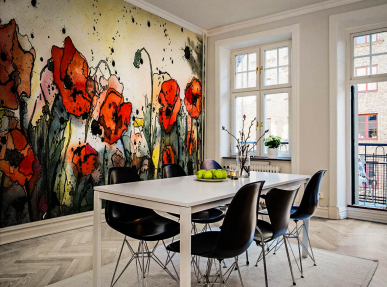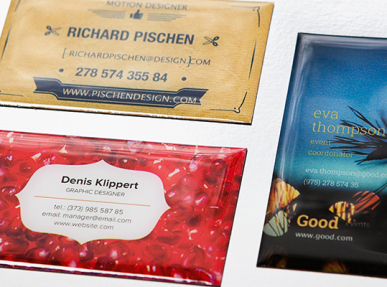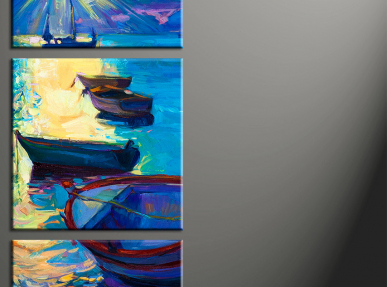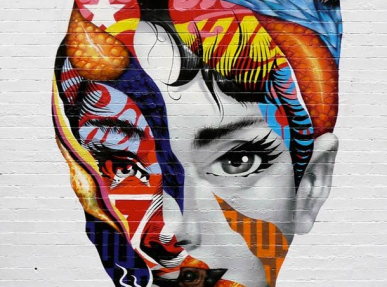Floral Patterns in the Interior Décor
Art & Photo Prints
Beauty of flowers excites our minds, especially when it comes to various options for decorative interior design. However, giving the existing abundance and great variability of floral patterns it’s not hard to get lost, wondering how to choose the right print, if a specific style is clearly desired for the interior.
Read on to find out how to use the floral pattern in the interior correctly, what types of floral prints exist and in what interior styles they look best.
Using a floral pattern, it is important:
1. Knowing where to stop
Do not overly saturate the room with patterns. It is better if floral motifs are present only on the walls, on the floor, in the design of the ceiling, in textiles and decor, or in small quantities in one of the areas of the room, for example, in the upholstery of a chair and pouffe by the fireplace.
A slightly more neutral pattern can be applied a little more actively, but if the flowers are painted in rich colors, the interior of the room risks turning from refined and stylish into tasteless and ridiculous.

2. Combine correctly
Floral patterns can be perfectly paired with graphic prints that emphasize the beautiful silhouette of plants. You can combine flowers with a strip, a cage or peas, or you can completely abandon such combinations in favor of a clean light, color or dark background.
3. Experiment
Take a chance, and choose a completely unfamiliar performance of the floral pattern: stylization, graphics, or the contrast of light and saturated colors.
Types of Floral Patterns

Natural Pattern
The flower pattern is able to get along well with other prints, which makes it almost universal, but at the same time, it is a very self-sufficient pattern, fragments of which can be used in separate objects. Moreover, the pristine charm (or originality and realism) of different types of flowering plants is especially good in traditional stylistic directions.
That is, for example, the interior in classic English or French styles very often demonstrates the use of floral patterns with lush roses, peonies or magnolias in textiles and upholstery of upholstered furniture. By the way, the nature of this or that plant sounds completely believable in them, as if it was created with the brush of a painter painting from nature.
Stylized Print
Stylization of a pattern is its simplification and absolute brevity, but in order to depict a drawing like this, it is necessary to choose the basic, characteristic features of it: volume, lines or shape. The art of styling is the ability to use minimal graphic means to form an image from its characteristic features.
A cursory impression of this or that kind of flower is its stylization, which you could use when decorating the interior in one of the modern styles: Art Nouveau, Art Deco, Pop Art, and Contemporary.

Black and White Motifs
Flowers remain flowers even in the absence of a pronounced saturation of shades. Try to use the achromatic scale (from white to dark gray, including black) locally, only with the aim of somewhat softening the restrained atmosphere in the style of minimalism or high-tech, or perhaps contemporary.
It is better to pick up objects with large enough, but rare colors for accent objects: a canvas with photo printing, a carpet, an armchair, a pair of pouffes or decorative pillows. Thanks to the discreet palette of colors, they will not distract or annoy, but fragments with flowers will make the image of the interior more comfortable and inviting.
Large and Dense Floral Pattern
A pattern like this looks beautiful, vibrant and incredibly dynamic in the interior, and yet, there are recommendations regarding its use. For example, a too active bright floral pattern should be used only on one surface, what it will be: walls (niches), ceiling or floor, it’s for you to decide.
Companion colors for a large print with flowers are white and all its shades, as well as one or two colors selected from the general palette of a dense pattern. It may look like this: the walls are covered with large floral pattern wallpaper containing green, blue, terracotta, azure, and sand shades. While nearby you can place, for example, chairs with blue or terracotta upholstery, or a sand-colored carpet.
A large floral pattern is especially harmonious in a room with furniture of simple geometric shapes and a minimum of decorations.

Sophisticated Pastel Colors
Most often these are naturalistic images of different types of flower plants, from field daisies to garden roses, camellias and tulips. It is important to choose a soft neutral tonal saturation of the picture, so that it becomes more like a pleasant background than a flashy accent.
Not entirely original, but very successful will be the decision to decorate any part of the wall with pastel wallpaper with elegant plants. The head of the bed, a mirror in a curly frame, a bright decorative object or a fireplace portal in the living room will be a beautiful silhouette against such a background.
Slim Solid Pattern
Such a pattern can be used when the image of the interior is already formed, but this image is simple, thoughtful, not burdened with unnecessary details. Perhaps the style of your room is Biedermeier or classicism, then the floral motifs in it should be applied, carefully "weaving" into the general atmosphere. It is best and easiest to use patterns with homogeneous plant weaves, in textiles with a pronounced texture (dense linen, waffle cotton fabric).

Graphic Flowers
The interior in which the graphic floral pattern is designed in a bright palette will be called colorful and very cheerful. Graphics can sometimes be confused with stylization, but in the first case features of the pattern are clearer and the silhouettes are more realistic. A flower becomes graphic when it is applied to an object using only one shade, while the volume is lost. For example, the upholstery of a chair is green, against which white flowers, outlines clearly resembling roses, are graphics.






 382
382 0
0 Art and Photo Prints for Bedroom Decor
Art and Photo Prints for Bedroom Decor
 3D Wall Murals in the Interior Decor
3D Wall Murals in the Interior Decor
 Expanding Living Space with Wall Murals
Expanding Living Space with Wall Murals
 How to Choose a Suitable Poster for Your Room?
How to Choose a Suitable Poster for Your Room?
 Elegance of English-Style Interior Decor
Elegance of English-Style Interior Decor
 The Best Color Solutions for a Harmonious Small Kitchen
The Best Color Solutions for a Harmonious Small Kitchen
 Practical and Comfortable Ikea-style Interior
Practical and Comfortable Ikea-style Interior
 Tips on Creation of Fusion Style in the Interior Decor
Tips on Creation of Fusion Style in the Interior Decor
 Interior Accomplished in Neoclassical Style
Interior Accomplished in Neoclassical Style






